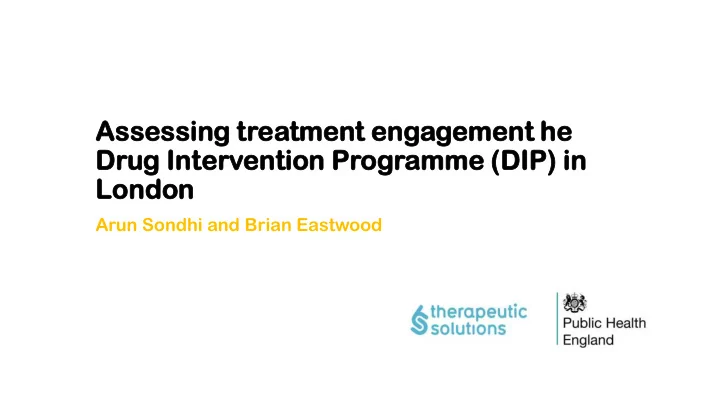

Asses essin sing g treatmen tment engagement ement he Drug ug Inter terventi ention n Prog ogramm amme e (DIP) P) in London don Arun Sondhi and Brian Eastwood
Drug Intervention Programme Identify opiate/crack- DIP teams engage, refer Assumes treatment = cocaine users in police and support offenders to reductions in offending custody treatment (Skodbo et al, 2007)
How it Works Police Custody Engagement Treatme ment Use of Requi uired Positive Test on arrest Assessme ment nt/ Test Cond nditiona nal Caut utioni ning ng (Care Planning) and See DIP Eng ngage Treatme ment nt Complete Forma mal Referral to Service treatme ment worker treatment Voluntary Engage assessment Cell sweep detainee
Background Diversion schemes within police custody have focused on two models Arrest referral – Referral to treatment Case- managed approaches to ‘hand - hold’ detainees into treatment (defined by having a care plan)
Study Aims • To examine factors that affect engagement with DIP in London (study funded by Mayor’s Office for Policing & Crime) • Test the veracity of two DIP models of engagement (‘arrest referral’ and case -managed DIP) • Examine treatment outcomes (‘successful’ discharge from treatment) for each model
Methods • Prospective Data linkage for all contacts in 2017 Metropolitan Police ‘drug test recorder’ + CJ - DET ‘DIP contact’ + National Drug Treatment Monitoring System (NDTMS) • Logistic regression models assessing engagement at: (a)Initial take- up of DIP ‘offer’ in police custody (b) Factors associated with a ‘successful’ treatment outcome
Diversion Process in London No further contact 40% Case-Managed Model Prison 13% 52% (n=1,656) Community Treatment 47% Positive Drug Test Community Treatment Prospective contact 9.910 individuals 35% (n=1,113) 32% (n=3,188) (13,863 events) Community + Treatment 22% Arrest Referral Model Prison-based Treatment Prison 24% 48% (n=1,532) 18% (n=585) Historical record prior One-off CJIT contact to test 13% (n=1,270) 18% (n=1,754) No further contacts 54% Multiple CJIT contacts 14% (n=1,434)
Results • Factors associated with initial DIP engagement in police custody: (a) Housing problem (e.g. NFA)* (b) ‘Taking without Consent’ (TWOC) offence (c) Opiate; cannabis users (but not cocaine)* (d) Binge Drinkers* *Holds after Bonferroni correction
Results • Models of successful treatment outcome: (1) non-acute Housing need (2) Cocaine users* (3) Case-managed rather than arrest referral* (1) Female detainees* (2) Acute housing need (e.g. NFA) (3) Opiates and crack users* *Holds after Bonferroni correction
Conclusions • DIP model engages “traditional” opiate users but less effective for crack users • Case-management diversion schemes facilitate treatment engagement • Treatment still struggles to engage opiate/crack-using offenders • Specialist approaches required for female offenders
Final Thoughts • Drug diversion should be seen as the sum of all its parts e.g. ensuring successful treatment outcomes • Integrate holistic approaches e.g. housing support • Is the model out-dated? • And we really don’t know much about causality (effect on reoffending)
Recommend
More recommend